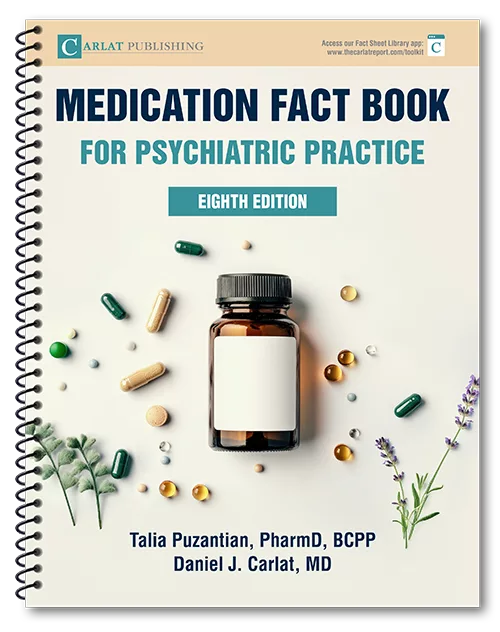Brexanolone has quietly exited the pharmaceutical stage, and we look at what that means for its stand-in, zuranolone (Zurzuvae), in postpartum depression.
Publication Date: 07/14/2025
Duration: 12 minutes, 50 seconds
Transcript:
CHRIS AIKEN: On April 15, 2025, Sage Therapeutics withdrew their postpartum depression breakthrough – IV brexanolone – from the US market. Today, we look at what was lost and what to do without it.
KELLIE NEWSOME: Welcome to The Carlat Psychiatry Podcast, keeping psychiatry honest since 2003.
CHRIS AIKEN: I’m Chris Aiken, the editor-in-chief of The Carlat Psychiatry Report.
KELLIE NEWSOME: And I’m Kellie Newsome, a psychiatric NP and a dedicated reader of every issue.
CHRIS AIKEN: We launched the first Carlat podcast in May of 2019, just two months after the FDA approved brexanolone (Zulresso) as the first medication for postpartum depression. Six years later, the manufacturer withdrew brexanolone to focus on its oral version – zuranolone (Zurzuvae). However, these two medications are different. Brexanolone is intravenous, and zuranolone is oral, and that means different plasma levels and a potentially different effect sizes. Today, I am going to explore this drug and its oral cousin, starting with that’s lost in the transition: Potency. In terms of potency, IV brexanolone has a very large effect size – 1.2 – while oral zuranolone’s effect size is only moderate, 0.5 (Kanes S et al, Lancet 2017, 390(10093):480-489). An effect sizes of 1.2 is remarkable – very few treatments in psychiatry rise above 1.0 –among them ECT and IV ketamine. Yes, I said IV ketamine. The IV version has an effect size similar to brexanolone’s – 1.2 – but its effect size falls to 0.3 when we use the intranasal version (esketamine) – Spravato. IV meds are more common in Europe, where inpatient psychiatrists have long used IV valproate for mania and mixed states, and IV citalopram for depression. Anecdotally, these psychiatrists tell me they get better results with the IV drug. Sage Therapeutics’ decision to withdraw IV brexanolone last April was a business one, as the drug faced many obstacles in the US. It requires a 60-hour intravenous infusion and a REMS program, and has to be administered in a certified healthcare setting. Both zuranolone and brexanolone are sedating, but the IV version caused some women to pass out, so they needed to be monitored during those 60 hours. And it was expensive - $34,000 just for the drug, not to mention the hospital care. The fact that it was released just a few months before COVID lockdown, also added to its woes. All in all, just over a thousand women actually received the IV drug. With all of those challenges, Sage swiftly developed an oral formulation of zuranolone, which the FDA approved for postpartum depression in 2023. Brexanolone is administered intravenously over 60 hours, while zuranolone is taken nightly for two weeks. While not as powerful as brexanolone, it still offers many of its advantages for postpartum depression.
1. It delivers results within 3 days, which is crucial for postpartum depression, where each day of symptoms takes a measurable toll on infant development.
2. It addresses one of the underlying causes of postpartum depression – the drop in neurohormones, particularly allopregnenolone. Zuranolone is a synthetic analogue of allopregnanolone.
3. It has a larger effect size than the SSRIs, at 0.5 vs 0.3, which means zuranolone is probably more powerful, but we can’t say for sure as the two have never been compared head-to-head.
For many years, SSRIs were the go-to for postpartum depression, particularly sertraline (Zoloft), which has a favorable safety profile in breastfeeding. Zuranolone's safety during breastfeeding is unclear, so women should avoid breastfeeding while on it; however, they can pump and discard milk during the two-week treatment to maintain their lactation ability. Now that we’ve said goodbye to brexanolone, let’s take a closer look at its replacement. Zuranolone works quickly, within 3 days, and those improvements persist through the 14-day course of treatment (Deligiannidis KM et al, JAMA Psychiatry 2021;78(9):951-959). Those benefits start to decline about a month after stopping it – and we don’t know what happens beyond that as one month is the longest follow-up period. The postpartum trials for zuranolone enrolled women whose depression started as early as the third trimester or as late as one month post childbirth. Wait – can postpartum depression start before delivery? Yes it does, in fact in DSM it is no longer called postpartum depression – it’s peripartum – and the onset can be anytime during pregnancy and up to one month after delivery (however, zuranolone is not considered safe in pregnancy and was not started then, even if the depression began in pregnancy). ICD-11 stretches the postpartum cut-off a little longer – up to 6 weeks after delivery – and for most women, the peak onset is around 2 weeks after delivery. The women in the zuranolone trials were like most women - 63% of them had depression that began sometime in the first month after delivery. Even though the trial required depression to start before a month after delivery, that doesn’t mean zuranolone was started then. Delays in care are the norm here – in a recent study, only 1 in 10 women who were referred for postpartum depression actually made that mental health appointment. In the zuranolone trials, women had to be within a year of childbirth to start the medication, and the episode had to start in the first trimester or within a month after delivery. So that is the ideal candidate for this drug. For most women in these trials, the postpartum episode was their first episode of depression, though a small minority (14%) had recurrent depression. This matters, because this is a rapid-acting treatment that tapers off, so we’re going to need something more to keep people well if their depression is recurrent. None of the women in these trials had suicidality, psychosis, bipolar disorder, or recent substance use disorders – those were all excluded, and in this podcast series we are going to dive more into those and see what we can do for them, hint, it's not going to be zuranolone. So, we have a limited population where zuranolone is the right fit, but this medication is still a game-changer. I’ll get to why I think that more in the next episode. But first, let me explain how limited it is – zuranolone does not work in non-postpartum depression. The company tried to get it approved there, but failed (Carvalho T, Nat Med 2023;29(5):1032–1033). They’ve also tried it in PTSD, premenstrual dysphoria, tinnitus, and insomnia – and I’m not sure where those investigations stand. In regular depression, Zuranolone is no better than a benzo. It brings some quick relief but fades away after a few days. Actually, the benzos look better than that – alprazolam’s benefits in depression lasted up to a month in its trials – that’s right, alprazolam treated not just anxiety but core symptoms of depression in over a dozen short-term trials. I repeat short term. The company tried to get it approved as an antidepressant in the 1970s, but the FDA wouldn’t have it – they were worried about its abuse liability. Today’s FDA is a bit more liberal – as esketamine’s approval shows – and they might have approved zuranolone too, but 3 days of relief is not enough.
KELLIE NEWSOME: Let’s pause for a preview of the CME quiz for this episode. Earn CME for each episode through the link in the show notes.
1. What is a difference between brexanolone and zuranolone?
A. Brexanlone is delivered intranasally, while zuranolone is oral
B. Brexanolone has a smaller effect size
C. Brexanolone is more sedating and can cause patients to pass out
D. Brexanolone is not a controlled substance
CHRIS AIKEN: Zuranolone is scheduled as a control just like the benzos, and I think of it as a neurosteroid version of the benzos. It modulates the same GABA receptor, and though it attaches in different ways, its clinical effects are comparable, quickly treating anxiety and insomnia. In studies of recreational sedative users, zuranolone had a similar feel – and elicited similar liking – as a benzo. It’s possible that zuranolone works in postpartum but not regular depression because it addresses a known part of the pathology there – the sudden fall in allopregnanolone hormone levels after delivery, which destabilizes GABA-ergic transmission. That possibility is exciting, because it’s one of the first times that a psychiatric medication was arrived at by following a theory – rather than happenstance. And if that theory is correct, there’s one postpartum scenario where you may want to avoid zuranolone, or at least use it with caution. Although the drop in allopregnanolone triggers postpartum depression, biology is complex, and some women become depressed when allopregnanolone rises back. When does it do that? When they stop breastfeeding and resume menstruation. Studies link this post-breastfeeding depression to the rise in allopregnanolone, so it may not be a good idea to add more fuel to the fire with zuranolone in those cases (Burke CS et al, Arch Womens Ment Health 2019;22(1):55-63). Next week, we’ll look the hidden reason that makes zuranolone a game changer for postpartum depression. Hint: It has to do with bipolar disorder.
KELLIE NEWSOME: Join the conversation and get daily research updates from Dr. Aiken’s Daily Psych feed. Search for ChrisAikenMD on LinkedIn, Twitter, Facebook, and Bluesky.


_-The-Breakthrough-Antipsychotic-That-Could-Change-Everything.webp?t=1729528747)



